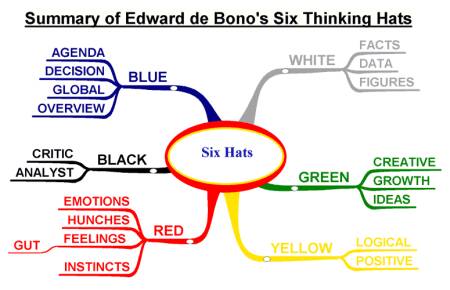‘Six Thinking Hats‘ is an important and powerful technique. It is used to look at decisions from a number of important perspectives (มุมมอง). This forces you to move outside your habitual thinking style, and helps you to get a more rounded view of a situation.
This tool was created by Edward de Bono in his book ‘6 Thinking Hats‘.
นักศึกษาที่ชื่อ น.ส.ศัลณ์ษิกา ไชยกุล ช่วยแปลจากคลิ๊ปให้
The Blue Hat
– What is our agenda?
วาระการประชุมของพวกเราคืออะไร
– What our next step and next hat?
หมวกต่อไปและก้าวต่อไปของพวกเราคืออะไร
– What is our decision?
การตัดสินใจของพวกเราคืออะไร
The White Hat
– What information is available?
ข้อมูลที่สามารถใช้ได้คืออะไร
– What information would we like and what do we need?
ข้อมูลอะไรที่ใช้ได้ และอะไรที่เราต้องการเพิ่ม
– How are we going to get the missing information?
พวกเราต้องทำอย่างไรเพื่อให้ได้รับข้อมูลที่สูญหายไป
The Yellow Hat
– What are the benefits?
ผลประโยชน์คืออะไร
– What are the positives and the values?
คุณค่า และการคิดบวกคืออะไร
– Is there a concept in the idea that makes it attractive?
พอจะมีความคิดอะไรในแนวคิดที่น่าสนใจหรือไม่
The Black Hat
– What could be the potential problems?
ปัญหาที่อาจจะเกิดขึ้นได้คืออะไร
– What could some at the difficulties be?
มีอะไรบ้างที่เป็นอุปสรรคหรือทำได้ยาก
– What are the points of caution and risk?
จุดที่ควรระมัดระวังและมีความเสี่ยงคืออะไร
The Green Hat
– Are there other ways that this can be done?
มีทางอื่นที่สามารถทำได้หรือไม่
– What else can be done?
มีอะไรที่ทำได้อีกบ้าง
– What will overcome our difficulties?
อะไรคือสิ่งที่จะเอาชนะอุปสรรคของพวกเรา
The Red Hat
– What are my feelings now?
ตอนนี้ความรู้สึกของฉันคืออะไร
– What does my intuition tell me?
สัญชาตญาณของฉันบอกอะไร
– What’s my gut reaction?
ปฎิกิริยาที่มาจากภายในคืออะไร
Many successful people think from a very rational, positive viewpoint. This is part of the reason that they are successful. Often, though, they may fail to look at a problem from an emotional, intuitive, creative or negative viewpoint. This can mean that they underestimate resistance to plans, fail to make creative leaps and do not make essential contingency (ฉุกเฉิน) plans.
Similarly, pessimists (ผู้มองในแง่ร้าย) may be excessively defensive, and more emotional people may fail to look at decisions calmly and rationally.
If you look at a problem with the ‘Six Thinking Hats’ technique, then you will solve it using all approaches. Your decisions and plans will mix ambition (ความใฝ่ฝัน), skill in execution, public sensitivity, creativity and good contingency (ฉุกเฉิน) planning.
How to Use the Tool:
You can use Six Thinking Hats in meetings or on your own. In meetings it has the benefit of blocking the confrontations (การเผชิญหน้า) that happen when people with different thinking styles discuss the same problem.
Each ‘Thinking Hat‘ is a different style of thinking. These are explained below:
—
1. White Hat: ใช้ข้อมูลข่าวสาร
With this thinking hat you focus on the data available (ข้อมูลที่มี). Look at the information you have, and see what you can learn from it. Look for gaps in your knowledge, and either try to fill them or take account of them. This is where you analyze past trends, and try to extrapolate (คาดการณ์) from historical data.
—
2. Red Hat: ใช้อารมณ์ความรู้สึก
‘Wearing’ the red hat, you look at problems using intuition (การหยั่งรู้ การรู้โดยสัญชาติญาณ), gut (ลำใส้) reaction , and emotion(อารมณ์). Also try to think how other people will react emotionally. Try to understand the responses of people who do not fully know your reasoning.
—
3. Black Hat: ใช้การตั้งคำถามหรือตั้งข้อสงสัยมุมลบ
Using black hat thinking, look at all the bad points of the decision. Look at it cautiously and defensively. Try to see why it might not work. This is important because it highlights the weak points in a plan. It allows you to eliminate them, alter them, or prepare contingency plans to counter them.
Black Hat thinking helps to make your plans ‘tougher(ยากขึ้น)’ and more resilient (ยืดหยุ่น). It can also help you to spot fatal flaws and risks before you embark (เริ่มดำเนินการ) on a course of action. Black Hat thinking is one of the real benefits of this technique, as many successful people get so used to thinking positively that often they cannot see problems in advance. This leaves them under-prepared for difficulties.
—
4. Yellow Hat: ใช้การมองในแง่ดี และมีความหวัง
The yellow hat helps you to think positively. It is the optimistic viewpoint that helps you to see all the benefits of the decision and the value in it. Yellow Hat thinking helps you to keep going when everything looks gloomy (มืดมน) and difficult.
—
5. Green Hat: ใช้การคิดอย่างสร้างสรรค์
The Green Hat stands for creativity. This is where you can develop creative solutions to a problem. It is a freewheeling way of thinking, in which there is little criticism of ideas. A whole range of creativity tools can help you here.
—
6. Blue Hat: ใช้การควบคุมความคิดทั้งหมดให้มองเห็นภาพรวมของการคิด
The Blue Hat stands for process control. This is the hat worn by people chairing meetings. When running into difficulties because ideas are running dry, they may direct activity into Green Hat thinking. When contingency plans are needed, they will ask for Black Hat thinking, etc.
—
A variant of this technique is to look at problems from the point of view of different professionals (e.g. doctors, architects, sales directors, etc.) or different customers.
http://www.mindtools.com/pages/article/newTED_07.htm
http://kittikoon.multiply.com/journal/item/47/47
http://www.debonogroup.com/six_thinking_hats.php
http://www.tistr.or.th/tistrblog/?p=754

Using Six Thinking Hats®, team will learn how to:
* look at problems, decisions, and opportunities systematically
* use Parallel Thinking™ as a group or team to generate more, better ideas and solutions
* make meetings much shorter and more productive
* reduce conflict among team members or meeting participants
* stimulate innovation by generating more and better ideas quickly
* create dynamic, results oriented (มุ่งเน้น) meetings that make people want to participate
* go beyond the obvious to discover effective alternate solutions
* spot opportunities where others see only problems
* think clearly and objectively
* view problems from new and unusual angles
* make thorough evaluations
* see all sides of a situation
* keep egos and “turf (สนามหญ้า) protection” in check
* achieve (การทำให้สำเร็จ) significant and meaningful results